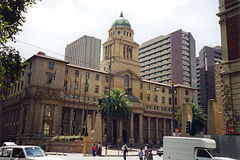Johannesburg City Hall
| Johannesburg City Hall | |
|---|---|

A view of the Johannesburg city hall from Rissik Street
|
|
| General information | |
| Status | Complete |
| Location | Johannesburg, South Africa |
| Coordinates | 26°12′16″S 28°2′30″E / 26.20444°S 28.04167°ECoordinates: 26°12′16″S 28°2′30″E / 26.20444°S 28.04167°E |
| Current tenants | Gauteng Provincial Legislature |
| Construction started | 1912 |
| Completed | 1914 |
| Opening | 1915 |
| Owner | Gauteng Provincial Government |
| Technical details | |
| Floor count | 4 |
| Lifts/elevators | 2 |
| Design and construction | |
| Architect | Hawkey & McKinley |
| Main contractor | Mattheus Meischke |
Johannesburg City Hall is an Edwardian building constructed in 1914 by the Hawkey and McKinley construction company. The plan for the building was drawn in 1910 and construction was started in 1913 and finished in 1914. The Gauteng Provincial Legislature currently occupies the building. The City Hall has seen many political events on its steps from protest meetings to a bomb blast in 1988.
A competition was held in 1909 to design a new Town Hall. Only South African resident architects were allowed to take part and entries were judged by Leonard Stokes, Vice-President of the Royal Institute of British Architects and a decision was made in March 1910. A Cape Town architectural firm, Hawke and McKinlay, won the competition to design the new building but it took until 17 February 1912 before Mattheus Meischke was awarded the tender to construct the building which would cost £503,000. The site chosen was the eastern end of Market Square where one half was purchased by the Johannesburg Town Council from the South African Government and then latter donated the other half on condition that a town hall was built. On 29 November 1910, the Town Hall's corner stone was laid by Prince Arthur, Duke of Connaught and Strathearn on land previously known as Market Square. Completed in December 1914, the Town Hall was officially opened on 7 April 1915 by the South African Governor-General Lord Buxton having been presented a golden key by the builder, Mattheus Meischke, with the building open to the public for two days. The building was officially in use earlier, having opened on 26 January 1915.
On 5 September 1928, Johannesburg was proclaimed a city by the Administrator of the Transvaal, J.H. Hofmeyer in front of a crowd gathered in the square of the now City Hall. In 1937, the City Hall would undergo further construction when the tower was dismantled and an additional floor was added to the building and then the tower rebuilt. On 12 October 1979, City Hall was designated a National Monument. After the 1994 South African elections, the Gauteng Provincial Legislature moved from Pretoria to Johannesburg and on 21 October 1995 the City Hall would become its new home. The Johannesburg City Council sold the City Hall in November 2001 for R20-million to the Gauteng Provincial Legislature with legal transfer occurring in 2003. The sale of the City Hall also included the Harry Hofmeyr Parking Garage, the archive areas of the Johannesburg City Library and the Beyers Naude Gardens which lies between the library and the hall.
...
Wikipedia
